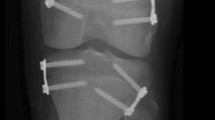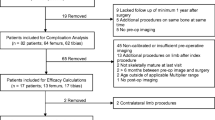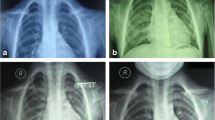Abstract
Objectives
Physeal drilling and curettage (PDC) and percutaneous epiphysiodesis using transphyseal screws (PETS) are among the most widely used techniques to treat leg-length discrepancy (LLD). This study compared the efficacy and outcomes between PETS alone and PETS combined with PDC (PETS + PDC).
Methods
Retrospective study of children who underwent epiphysiodesis of the proximal tibia or distal femur with either PETS or PETS + PDC between 2008 and 2018 at a single institution. Radiographic parameters and complications were reviewed at completion of treatment and most recent follow-up.
Results
A total of 23 epiphysiodeses in 15 patients, average age 13.1 years, with either PETS (13 femur/tibias) or PETS + PDC (10 femur/tibias) were included. PETS patients were treated for a longer time (median: 24 months vs 11 months, p = 0.004), however, follow-up time was similar between groups (p = 0.577), on average 2.7 years. In the PETS group, LLD decreased from 2.55 to 0.84 cm at most recent follow-up (p = 0.010), and in the PETS + PDC group from 3.01 to 1.2 cm (p = 0.005), achieving a correction of 1.71 cm for PETS and 1.83 cm for PETS + PDC (p = 0.871). A correction of LLD to ≤ 2 cm was achieved in 8 PETS (89%) and 4 PETS + PDC cases (67%) (p = 0.525). Two PETS patients (22%) and 1 PETS + PDC (17%) patient returned to the OR for further correction due to persistent LLD (p = 1.000). No differences existed in total number of complications, angular deformity or return to physical activity between groups (p ≥ 0.05 for each comparison).
Conclusions
This study showed equal efficiency in resolving LLD between the PETS and PETS + PDC procedures with minimal operative complications.
Level of Evidence III.

Similar content being viewed by others
Data Availability
The datasets generated during and/or analyzed during the current study are available from the corresponding author on reasonable request.
References
Bowen, J. R., & Johnson, W. J. (1984). Percutaneous epiphysiodesis. Clinical Orthopaedics and Related Research, 190, 170–173.
Canale, S. T., & Christian, C. A. (1990). Techniques for epiphysiodesis about the knee. Clinical Orthopaedics and Related Research, 255, 81–85.
Ogilvie, J. W., & King, K. (1990). Epiphysiodesis: two-year clinical results using a new technique. Journal of Pediatric Orthopedics, 10(6), 809–811.
Caskey, P. M., Baird, G. O., Tompkins, B. J., & Foley, R. P. (2009). Single-incision percutaneous epiphysiodesis of the lower extremity. Operative Techniques in Orthopaedics, 19(1), 31–35.
Metaizeau, J. P., Wong-Chung, J., Bertrand, H., & Pasquier, P. (1998). Percutaneous epiphysiodesis using transphyseal screws (PETS). Journal of Pediatric Orthopedics, 18(3), 363–369.
Troy, M., Shore, B., Miller, P., et al. (2018). A comparison of screw versus drill and curettage epiphysiodesis to correct leg-length discrepancy. J Children’s Orthop, 12(5), 509–514.
Dodwell, E. R., Garner, M. R., Bixby, E., et al. (2017). Percutaneous epiphysiodesis using transphyseal screws: a case series demonstrating high efficacy. HSS Journal, 13(3), 255–262.
Babu, L. V., Evans, O., Sankar, A., Davies, A. G., Jones, S., & Fernandes, J. A. (2014). Epiphysiodesis for limb length discrepancy: a comparison of two methods. Strateg Trauma Limb Reconstr, 9(1), 1–3.
Campens, C., Mousny, M., & Docquier, P. L. (2010). Comparison of three surgical epiphysiodesis techniques for the treatment of lower limb length discrepancy. Acta Orthopaedica Belgica, 76(2), 226–232.
Timperlake, R. W., Bowen, J. R., Guille, J. T., & Choi, I. H. (1991). Prospective evaluation of fifty-three consecutive percutaneous epiphysiodeses of the distal femur and proximal tibia and fibula. Journal of Pediatric Orthopedics, 11(3), 350–357.
Bayhan, I. A., Karatas, A. F., Rogers, K. J., Bowen, J. R., & Thacker, M. M. (2017). Comparing percutaneous physeal epiphysiodesis and eight-plate epiphysiodesis for the treatment of limb length discrepancy. Journal of Pediatric Orthopedics, 37(5), 323–327.
Borbas, P., Agten, C. A., Rosskopf, A. B., Hingsammer, A., Eid, K., & Ramseier, L. E. (2019). Guided growth with tension band plate or definitive epiphysiodesis for treatment of limb length discrepancy? Journal of Orthopaedic Surgery and Research, 14(1), 99.
Khoury, J. G., Tavares, J. O., McConnell, S., Zeiders, G., & Sanders, J. O. (2007). Results of screw epiphysiodesis for the treatment of limb length discrepancy and angular deformity. Journal of Pediatric Orthopedics, 27(6), 623–628.
Lykissas, M. G., Jain, V. V., Manickam, V., Nathan, S., Eismann, E. A., & McCarthy, J. J. (2013). Guided growth for the treatment of limb length discrepancy: a comparative study of the three most commonly used surgical techniques. J Pediatr Orthop Part B, 22(4), 311–317.
Makarov, M. R., Dunn, S. H., Singer, D. E., et al. (2018). Complications associated with epiphysiodesis for management of leg length discrepancy. Journal of Pediatric Orthopedics, 38(7), 370–374.
Niedzielski, K., Flont, P., Domzalski, M., Lipczyk, Z., & Malecki, K. (2016). Lower limb equalization with percutaneous epiphysiodesis of the knee joint area. Acta Orthopaedica Belgica, 82(4), 843–849.
Nouth, F., & Kuo, L. A. (2004). Percutaneous epiphysiodesis using transphyseal screws (PETS): prospective case study and review. Journal of Pediatric Orthopedics, 24(6), 721–725.
Song, M. H., Choi, E. S., Park, M. S., et al. (2015). Percutaneous epiphysiodesis using transphyseal screws in the management of leg length discrepancy: optimal operation timing and techniques to avoid complications. Journal of Pediatric Orthopedics, 35(1), 89–93.
Goedegebuure, W. J., Jonkers, F., Boot, A. M., et al. (2017). Long-term follow-up after bilateral percutaneous epiphysiodesis around the knee to reduce excessive predicted final height. Archives of Disease in Childhood, 103, 219–223.
Gordon, J. E., Chen, R. C., Dobbs, M. B., Luhmann, S. J., Rich, M. M., & Schoenecker, P. L. (2009). Interobserver and intraobserver reliability in the evaluation of mechanical axis deviation. Journal of Pediatric Orthopedics, 29(3), 281–284.
Moreland, J. R., Bassett, L. W., & Hanker, G. J. (1987). Radiographic analysis of the axial alignment of the lower extremity. J Bone Joint Surg Am Vol, 69(5), 745–749.
Paley, D., Herzenberg, J. E., Tetsworth, K., McKie, J., & Bhave, A. (1994). Deformity planning for frontal and sagittal plane corrective osteotomies. Orthopedic Clinics of North America, 25(3), 425–465.
Paley, D., Bhave, A., Herzenberg, J. E., & Bowen, J. R. (2000). Multiplier method for predicting limb-length discrepancy. J Bone Joint Surg Am Vol, 82(10), 1432–1446.
Monier, B. C., Aronsson, D. D., & Sun, M. (2015). Percutaneous epiphysiodesis using transphyseal screws for limb-length discrepancies: high variability among growth predictor models. J Children’s Orthop, 9(5), 403–410.
Stewart, D., Cheema, A., & Szalay, E. A. (2013). Dual 8-plate technique is not as effective as ablation for epiphysiodesis about the knee. Journal of Pediatric Orthopedics, 33(8), 843–846.
Kemnitz, S., Moens, P., & Fabry, G. (2003). Percutaneous epiphysiodesis for leg length discrepancy. J Pediatr Orthop Part B, 12(1), 69–71.
Funding
No funding was received.
Author information
Authors and Affiliations
Corresponding author
Ethics declarations
Conflict of Interest
MHY, RH, KJ, EDF, MSS and JFS declare that they have no conflict of interest. JAG reports a consultancy and honoraria with Stryker Spine outside the submitted work.
Ethical Standard Statement
This article does not contain any studies with human or animal subjects performed by the any of the authors.
Informed Consent
For this type of study informed consent is not required.
Research Involving Human Participants
All procedures performed in studies involving human participants were in accordance with the ethical standards of the institutional and/or national research committee and with the 1964 Helsinki declaration and its later amendments or comparable ethical standards.
Additional information
Publisher's Note
Springer Nature remains neutral with regard to jurisdictional claims in published maps and institutional affiliations.
Rights and permissions
Springer Nature or its licensor (e.g. a society or other partner) holds exclusive rights to this article under a publishing agreement with the author(s) or other rightsholder(s); author self-archiving of the accepted manuscript version of this article is solely governed by the terms of such publishing agreement and applicable law.
About this article
Cite this article
Younis, M.H., Hanstein, R., Javed, K. et al. Does Combining Drilling and Curettage to Percutaneous Trans-epiphyseal Screws Improve Correction of Limb Length Discrepancy? A Comparative Study. JOIO 58, 190–198 (2024). https://doi.org/10.1007/s43465-023-01070-7
Received:
Accepted:
Published:
Issue Date:
DOI: https://doi.org/10.1007/s43465-023-01070-7




